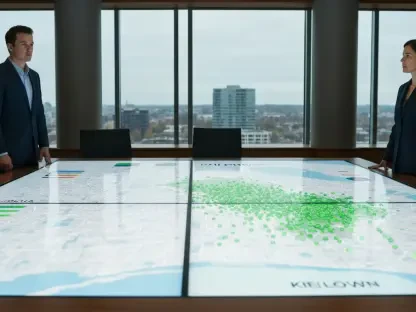I’m thrilled to sit down with Luca Calarailli, a renowned expert in construction, design, and architecture, whose innovative work at the intersection of technology and urban development is transforming the industry. Today, we’re diving into his pivotal role in delivering the Pendleton, Eccles, and Swinton Social Impact Guides for Salford City Council. This groundbreaking project redefines how social value is integrated into civic growth, offering practical tools for developers and investors while prioritizing community needs. Our conversation explores the essence of these guides, the collaborative process behind their creation, their alignment with broader ethical and environmental standards, and their potential to inspire similar initiatives elsewhere.
Can you give us a quick overview of what the Pendleton, Eccles, and Swinton Social Impact Guides are all about?
Absolutely. These guides are essentially a roadmap for developers and investors to understand the unique strengths and challenges in these three areas of Salford. They’re designed to ensure that as the city grows, every resident benefits from that progress. It’s about weaving social value into the fabric of development projects, providing clear insights and actionable steps to create positive, lasting impact in the community.
Why do you think these guides are such a significant step for Salford City Council and its residents?
They’re a game-changer because they shift the focus from development as just a physical or economic process to one that prioritizes people. For the council, it’s a way to set a high standard for ethical growth, ensuring projects align with the real needs of the community. For residents, it means their voices are heard, and they can see tangible benefits—like better access to opportunities or improved local services—coming from the growth happening around them.
How did your team become involved in this transformative project with Salford City Council?
We were approached through a competitive process, largely due to our expertise in sustainable and community-focused development. Our passion for integrating social impact with practical design solutions aligned perfectly with the council’s vision. Plus, with funding support from the UK Government’s Shared Prosperity Fund, it was an incredible opportunity to collaborate on something truly innovative.
Can you walk us through how these guides were developed and how you ensured they reflected the community’s actual needs?
It was a deeply collaborative process. We engaged with over 300 residents and 61 local organizations, alongside councillors, to gather a wide range of perspectives. We held workshops, interviews, and community sessions to really listen to what people wanted and needed. Every piece of feedback was analyzed to shape a framework that wasn’t just top-down but genuinely co-designed with the people who live and work in these areas.
What was some of the most unexpected or impactful feedback you received during those community engagements?
Honestly, I was struck by how much residents emphasized the need for small, everyday improvements over grand projects. Things like safer walking paths or more local job opportunities came up a lot. It was a reminder that social value isn’t always about big gestures—it’s often about the little things that make a huge difference in daily life.
How did partnerships with local councillors and community organizations influence the final shape of the guides?
Working with councillors and groups like Salford CVS was crucial. They brought deep local knowledge and helped us prioritize issues that might not have been obvious to outsiders. Their input ensured the guides weren’t just theoretical but rooted in the real dynamics of the area, making them far more relevant and actionable.
What does ‘embedding social value’ mean in the context of this project, and why does it matter so much?
Embedding social value means making it a core part of every stage of development—planning, building, and even long-term operations. It’s about ensuring that projects don’t just meet legal requirements but actively contribute to the well-being of the community, whether through job creation, environmental benefits, or social inclusion. It matters because without this focus, growth can leave people behind, and that’s the opposite of what a city like Salford is striving for.
How do these guides transform from a planning requirement into a fundamental part of the city’s growth strategy?
They go beyond being a checkbox by becoming a blueprint for how development should happen. They’re integrated into planning, procurement, and even how assets are managed over time. This makes social value a non-negotiable part of Salford’s future, ensuring every project aligns with the city’s broader vision for fairness and sustainability.
Can you explain how the guides connect to broader environmental, social, and governance principles, as well as industry guidance?
Sure. The guides are built on ESG principles, meaning they balance environmental sustainability, social responsibility, and good governance. They also align with standards from bodies like the UK Green Building Council, ensuring they’re not just local in scope but meet national and even global benchmarks for ethical development. This connection gives them credibility and makes them a model others can learn from.
What are some practical tools or strategies in the guides that developers and investors can directly apply?
We included specific delivery routes, like frameworks for community engagement or partnerships with local organizations for hiring and training. There are also tools for assessing impact, such as checklists and metrics to track how a project benefits the area. These are designed to be straightforward, so even those new to social value can implement them effectively.
How do the guides help measure social impact, and what standards do they align with?
They provide clear measurement tools, like indicators for job creation or community well-being, that let developers quantify their impact. These tools are aligned with national standards, ensuring the data is reliable and comparable. It’s about accountability—making sure promises made in the planning stage translate to real outcomes.
Do you see this model being adapted by other local authorities, and if so, how might it vary in different regions?
Definitely. The approach is scalable because it’s built on collaboration and adaptability. In other areas, the specifics—like local challenges or priorities—might differ, but the core idea of co-designing with communities can work anywhere. It could look different in rural versus urban settings, for instance, but the principle of putting people first remains universal.
The vision for Salford includes creating a fairer, greener, and healthier city. Can you highlight one specific way the guides contribute to this?
One key way is through promoting greener initiatives. The guides encourage developers to incorporate sustainable design, like green spaces or energy-efficient buildings, which directly supports a healthier environment. This not only improves quality of life for residents but also aligns with the city’s broader goals for sustainability.
What were some of the biggest challenges you faced while creating these guides, and how did you tackle them?
One major challenge was balancing diverse opinions from so many stakeholders. Not everyone agrees on priorities, so we had to find common ground through lots of dialogue and transparency. We also had to ensure the guides were practical, not just idealistic, which meant constant refinement to make sure they worked in real-world scenarios.
What’s next for your team and Salford City Council after delivering these guides? Are there plans to build on this work?
We’re already discussing how to expand this framework to other parts of Salford and potentially refine it based on early feedback from implementation. There’s also interest in sharing lessons learned with other councils, so we’re looking at ways to support broader adoption. The goal is to keep evolving this model to maximize impact.
What is your forecast for the future of social value in urban development?
I think social value will become non-negotiable in urban development over the next decade. As communities demand more accountability, and as funding and policies increasingly prioritize impact, frameworks like these guides will be standard. My hope is that we’ll see a shift where every project is judged not just on profit or aesthetics, but on how it uplifts the people and places it touches.









